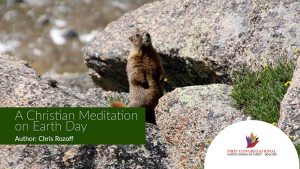You can listen to this week’s Devotional here
Author: Kevin Pettit
“The true light, which enlightens everyone, was coming into the world.” — John 1:9
As I sit to write this devotional, and more specifically as you sit to read it, we readers in the earth’s northern hemisphere live under a sky with the shortest period of daylight and longest night of the year, when the Sun is at its lowest daily maximum elevation in the sky. This is the Winter Solstice which occurs because of the 23.4⁰ difference between the axis of earth’s spin and the axis of the earth’s orbit in its path about our sun. The harkening of winter accompanies this event, not because our hemisphere is further distanced from the sun, but because the light from the sun hits our hemisphere at a more glancing angle, and the light is more easily reflected away from the earth’s surface.
For millennia, inhabitants of the earth have celebrated the Winter Solstice as the rebirth of the sun which will appear to shine for a greater length of time each day until the Summer Solstice in June. It was not until the year 336 CE that the Emperor Constantine decreed that the birth of Jesus of Nazareth would be celebrated in conjunction with the dawning of more light in the Roman Empire. Space.com says that “[h]istorians speculate this was done by the Emperor as a move to weaken established pagan celebrations that occurred around the Winter Solstice. The date would not be accepted by the Eastern Empire for around another 500 years, and Christmas wouldn’t become a major Christian festival until the 9th Century.”1
But what does the Winter Solstice mean for us today? Now, practically speaking, the 20th day of December might have been a reminder that we should have bought and wrapped all of our Christmas gifts already. But it is also a time to celebrate the advent of more light. To me, this means more than just a greater intensity and daily illumination by the sun’s rays; more light also means more revelation, more of our own understanding, more insight. With this expanded meaning of light, we celebrate the increased depth of all of these things!
This is also a time when we can celebrate change. Despite this season of the Winter Solstice being one in which the length of the day changes the least from day to day, to me, the growing light signifies all the good changes that can be inspired by our God. Most all the lectionary readings for the past week speak of a God whose “steadfast love was established forever” (Psalm 89:2), and a God of constancy. Scriptures attest to the firm foundation found in our God; however, I also find hopeful the fact that our God is dynamic and enters into this world, not only in the birth of the baby Jesus about two thousand years ago, but also in a Christ spirit that can be born in us continually. I believe that our celebration of Christmas each year at this dark time – in the northern hemisphere – invites us to keep the Christ spirit alive and that, just as our sun’s daily appearance persists longer, more will be revealed to those of us who seek to live in and manifest the spirit of Christ. However, unlike the variable intensity of the sun’s light, the light of Christ is always available to help lead us forward.


